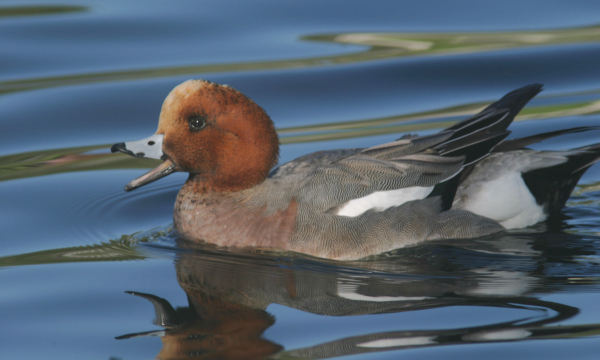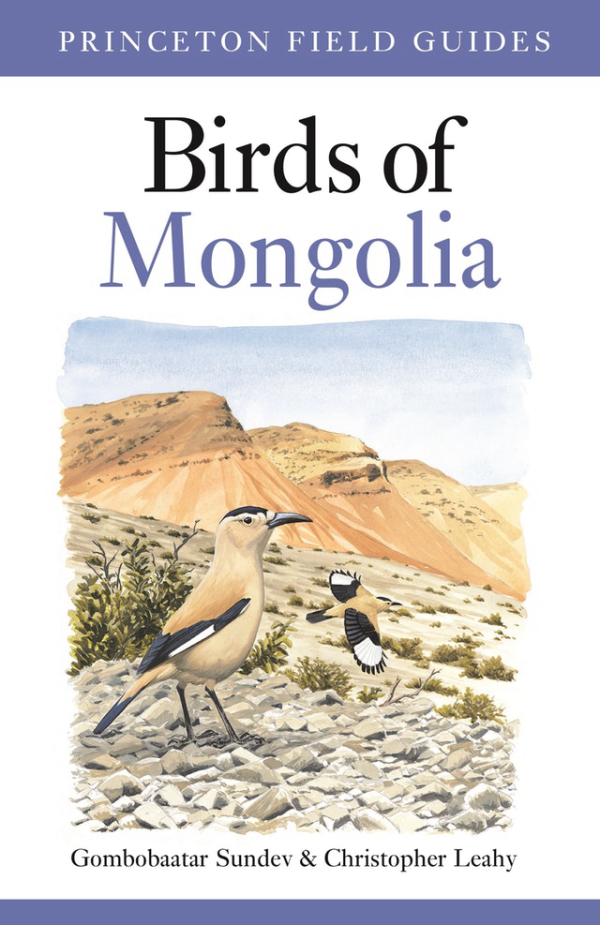
The attraction of Mongolia’s birdlife is reflected by a feisty drake Eurasian Wigeon.

Birds of Mongolia
|
When I received the new Princeton University Press publication, Birds of Mongolia, I initially thought it was probably not very relevant to readers – but I was excited to work my way through the book personally – after all, the Steppe region of Asia is the grassland equivalent of the Northern Great Plains, where I now reside. In fact, the 47th Parallel North passes through both Mongolia and North Dakota, and both locations are in the center of the respective continents. Then too, I have worked in northeast China, where the avifauna is similar to Mongolia.
I quickly became pleasantly immersed in the book, spent an hour going through it page by page, and realized I must share it with The Birding Wire readers, although in a less than conventional “book review” manner. Some people like to read novels, but I like to read books about wildlife, and I relish pouring over a good field guide and enjoy some surprises, absorb new information, and pick out a few really interesting species that I’d really like to observe in person and even photograph. Many are the trips I’ve taken abroad with the focus of observing certain birds in their native lands.
I am a great appreciator of expansive grasslands and the birds found there through the seasons, but I was surprised when my friend Vladimir Flint shared with me that the Steppe, the grasslands of central Asia, were his favorite Russian environ. Vladimir was the foremost ornithologist in the former USSR and the author of the book Birds of the USSR. I would have guessed Dr. Flint would appreciate Arctic Siberia more, or the Tamyr Peninsula or Kamchatka more, but those would be my impressions rather than his. I always appreciated Vladimir’s surprise preference, and after taking a closer look at Birds of Mongolia, I have a better appreciation for the “Great Plains” of central Asia.
But Mongolia has other habitat types in addition to the Steppe grasslands, including the associated mountain forests and grasslands, wetlands and large lakes, and along the southern border the famed Gobi Desert. The authors, Gombobaatar Sundev and Christopher Leahy, provide representative color landscape and habitat photos that show the lay of the land from north to south.
The cover made me want to check out the book as much as anything after I recognized the birds illustrated were the unique Henderson’s Ground Jays, described as an iconic bird of the Gobi Desert, and a species I didn’t know existed until just a few years ago. Inside this volume, so many other remarkable species caught my attention: Great Bustards and Macqueen’s Bustards, Wallcreepers, Red-footed Falcons, White-naped Cranes, Black Woodpeckers, Bearded Reedlings, Yellow-breasted Buntings and Red-headed Buntings, Pallas’s Sandgrouse, Smew, Oriental Plovers, Bearded Vultures, Black-billed Capercaillie, Reed Parrotbills, and Siberian Blue Robins – even Eurasian Jays are impressive birds and considerably different-looking from any jays in the Western Hemisphere.
For some North American birders this list of spectacular birds contains unfamiliar bird names, but I list them here them to introduce them to you, to encourage you to look the most interesting of these up, or all of them, to see them illustrated and simply described at http://datazone.birdlife.org/ or, better yet, grab a copy of “Birds of Mongolia.”
Many families of birds show much more diversity in Asia, and specifically Mongolia, than we have here in North America. For instance, there are three times as many species of cranes in Mongolia, where you can find six different cranes. The smallest of the world’s cranes, the beautiful Demoiselle Cranes, which stand only three feet tall, are the most common of Mongolia’s cranes and they nest in open grassland habitats – the Steppe. Common Cranes and White-naped Cranes also nest in wetland habitats and form migratory flocks, plus three extremely rare species of cranes also migrate through the region, including Red-crowned Cranes, Siberian Cranes, and Hooded Cranes – all memorable birds to see, and hear, in the wild.
Raptors are especially varied in Mongolia; consider that there are six species of harriers, including my favorites – Pied Harriers. There are nine falcons, with the dramatic Saker Falcons and an impressive collection of flashy smaller falcons such as Eurasian Hobbys, Amur Falcons, the aforementioned Red-footed Falcons, and Lesser Kestrels. Eight eagles are present in Mongolia, which is famed for its large Golden Eagles and as a stronghold for nesting Steppe Eagles. Booted Eagles are another interesting species due to their small size for an eagle. Waterfowl are also very diverse, as are shorebirds and the region boasts seven species of shrikes, including the Northern Shrikes we are most familiar with.
Also some familiar birds are among the Mongolian species beautifully illustrated and described – especially among the northern owls, raptors, and waterfowl. You will recognize the following list of birds found in North America, and Mongolia, and may be enlightened about their expansive ranges across the Northern Hemisphere, including Great Gray Owls, Boreal Owls, Northern Hawk Owls, and Snowy Owls; Rough-legged Hawks, Gyrfalcons, Peregrine Falcons, and Merlins; plus Northern Shovelers, Northern Pintails, and Tundra Swans. In addition, you can find Northern Shrikes, Horned Larks, Lapland Longspurs, and Snow Buntings – and even this list is not comprehensive.
We also see some of the Asian species listed in the Birds of Mongolia in the weekly Rare Birds articles provided in The Birding Wire, another reason for adding this new book to your library for quick reference. Without doubt, part of my enjoyment of this field guide is that I have worked in eastern Asia – in northeast China and far eastern Russia – where I had the honor to study many of the birds that nest in Mongolia, and I have visited north-central India during winter, which is where many Mongolian nesting birds migrate to during the off-season.
If you’re looking for a good novel, consider opting instead for the Birds of Mongolia; I strongly recommend it, if you’re interested in birding in Mongolia, looking to expand your appreciation of birding beyond our horizons, or if you would like to learn more about the birds of central Asia – they are fascinating; hence, so is this new book. See https://press.princeton.edu/books/paperback/9780691138824/birds-of-mongolia
Article and photographs by Paul Konrad